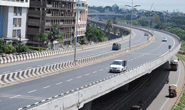Use of high capacity, modern, computerised and controlled batching plants with different types of admixtures to get the desired quality of concrete is now common for major project sites in the country.
There have been several technology achievements in bridge design and construction in India over the past decade. Indian engineers, contractors and bridge designers have developed several state-of-the-art construction and design technologies as a result of which India is now on par with other developed countries in this field.
High performance concrete with M 90 grade of concrete meeting all durability aspects is not new to us. Use of high capacity, modern, computerised and controlled batching plant up-to 200 m3/hr with different types of admixtures to get the desired quality of concrete, in a most economical manner, is now common for major project sites in the country. India has mastered the art of bridge construction technology in the sea by using modern construction equipment. Extensive use of precast techniques to accelerate the works and development of good launching system which was necessary for large scale Metro rail work has become a common feature. The completion of a 8-km long elevated road for Metro rail in Delhi in a span of two years stands testimony to the abilities of Indian engineers.
For the Pimpalgaon-Nashik-Gonde road project located in Maharashtra, L&T IDPL has designed and executed highly innovative bridgeworks. The second longest elevated road of 5.5 kilometres with segmental construction was completed in a record time of two years. Almost all components of the superstructure are precast, piers are constructed using single form work of 6m height, efficient launching system and extensive use of management techniques which has made this possible. The entire four-lane elevated corridor has been made so elegant that, it is supported on a single pier with long cantilever superstructure resembling a fish bone form. This form type created larger area for the local traffic plying in this corridor. High performance concrete, self-compacted concrete and adoption of modern equipment as boom placer was extensively used in this project.
The project also has a 461m long flyover at Garware where, a unique structural design is adopted. The structure is designed as a continuous structure for live loads. The thin slender beam without cross girder had raised several questions in the mind of consultants who were doing the design review. The construction sequence was so evolved that, for achieving live load continuity, the girders did not require support.
Initially, the central portion of the deck slab was casted and then the deck structure on support was casted. This sequence has given lot of advantage in reduction of internal forces resulting in a cost optimised structure. The cost of structures in this project is more than 70 per cent of the project cost. Structurally efficient forms with several state-of-art technologies are the unique features which have resulted in optimised project cost. As it was a DBFOT project, the design team had the leeway to innovate.
The 63m long bridge across Kadwa River, Maharashtra which crosses the project highway is designed & constructed as an integral structure. The bridge has been designed elegantly and provides maximum riding comforts to road users with minimum joints making the bridge bearing less. Designers, engineers and contractors will continue to implement such state-of-the-art technologies in India resulting in invaluable improvement in the condition of urban streets and traffic patterns. Elevated structures have opened our country, enabled goods and services to reach remote areas, encouraged the growth of suburbs and provided people everywhere with greater options in terms of access to jobs, health care, services, education, and cultural resources. Above all, highways in general and bridges in particular have provided India with one of our most cherished assetsùthe freedom of mobility.
This article has been written with contributions from PL Bongirwar, Advisor to L&T, D Ravindra Subbhiya, Chief Design Engineer, L&T Infrastructure Development Projects Limited (L&T IDPL), Naveen G, Deputy Manager-Structural Design, L&T IDPL.



Leave a Reply
You must be logged in to post a comment.